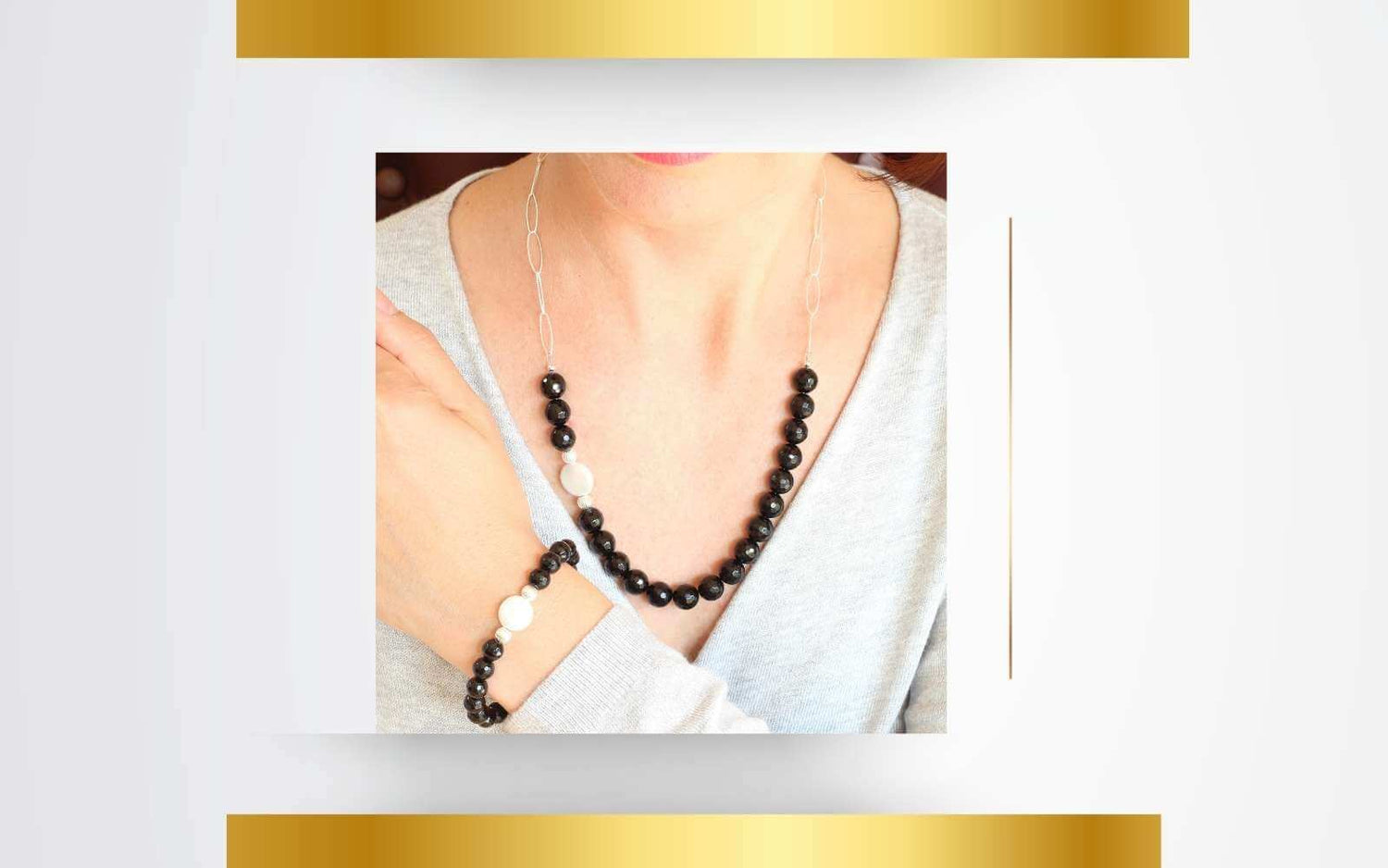
Necklaces with Pearls – From Classic to Modern
Necklaces with Pearls
Famously Coco Chanel once said that "a woman needs ropes and ropes of pearls". Whether you like to adorn yourself with ropes of pearls or wear just a delicate one, pearls hold a serene and lustrous beauty admired by many. Necklaces with pearls come in many different styles making it almost impossible not to find one that suits your lifestyle and fashion preferences.
The Symbolism of Pearls
Pearls are the result of the creature protecting itself from outside irritations which is why they are considered the gemstone of nourishment and nurturing. Wearing necklaces with pearls gives the wearer a sense of confidence and assurance. Pearls are soothing and carry maternal, nurturing and supportive vibrations.
They represent wisdom gained through experience. Pearls will help you learn the lessons from every life experience and will make you wiser and stronger for it. Pearls are said to promote faith, loyalty and truth. They have long been associated with purity, humility and innocence. Necklaces with pearls have been traditionally given as a wedding gift. Also, pearls remain the gemstone known as the June birthstone.
What is a Pearl?
A pearl is a hard, glistening object produced within the soft tissue of a living shelled mollusc. Pearls are the only gemstones in the world that come from living creatures. The main component of pearls is calcium carbonate (CaCO3) known as aragonite crystals. There are two main categories of pearls: freshwater and saltwater. Each type then can be natural and cultured. Unlike gemstones that are measured by carat, a pearl’s weight is given in grains.
Pearl Hardness
Pearls are ranked 2.5 on the Mohs hardness scale, which means they are very soft and easily scratched. The hardness of pearls is low, however, pearls are tough due to their microcrystalline structure. This is also partly due to the organic matrix holding the individual crystals together resulting in a stronger structure making it almost impossible to break pearls into pieces.
The Formation of Pearls
A Pearl is created when a very small fragment of rock, a sand grain or a parasite enters the mollusc’s shell. It irritates the oyster or clam, which reacts by coating the foreign material with layer upon layer of shell material called nacre. The nacre is also a substance that gives pearls their lustre. Some pearls take six months to form while bigger pearls can take up to four to five years to grow.
Where Do Pearls Come From?
Unlike most gemstones that are found on the Earth, pearls have an organic origin. In saltwater settings, pearls are found in oysters, while in freshwater they are produced by mussels. Almost all pearls today are cultured on pearl farms.
Japan and China both produce Akoya cultured pearls. Australia, Indonesia, and the Philippines are leading sources of the South Sea saltwater cultured pearls. Tahitian pearls are cultivated primarily around the islands of French Polynesia of which the most familiar is Tahiti. China is the leading source of freshwater cultured pearls.
Cultured Pearls Types
There are four main types of cultured pearls used in necklaces with pearls and other jewellery. Each of them is special in its own way and valued for its distinctive characteristics.
- Akoya cultured pearls - are saltwater cultured pearls from the Akoya oyster. White and cream-coloured pearls are mostly used in single-strand necklaces as they are known for being perfectly round.
- South Sea cultured pearls - are the most valued of all pearl types as it takes a long time for them to grow. They are usually bigger and come in white or silver to golden colours.
- Tahitian cultured pearls - are all about pearl overtones. The pearls’ body colour might be grey, black or brown, with blue, green, purple or pink overtones.
- Freshwater cultured pearls - are the most commonly produced pearls with wide commercial availability. They have a wide range of sizes, shapes and colours.
Freshwater Pearls
Necklaces with pearls in our jewellery range feature freshwater cultured pearls. We like to mix pearls with gemstones and add them as a special feature in our gemstone necklaces rather than making pieces only with pearls. An abundant selection of shapes, sizes and colours makes freshwater pearls an affordable and innovative option for creating new looks, styles and combinations. Recently they have increased in popularity offering the most unique and interesting designs.
Shapes in cultured freshwater pearls can vary due to their cultivation process. They are generally smaller with less lustre than saltwater pearls as they take a shorter time to form. Over 90% of freshwater pearls are irregular in shape. The irregular shapes we use in pearl necklaces and pearl earrings include; oval, baroque, stick and coin. As for their colour, white and cream shades with overtones of pink and cream are the most typical.
Coin Pearls have been cultured to the shape of coins. They typically grow to around 10-12 mm in size.
Baroque pearls are irregular in shape and can vary widely with unique features and growth characteristics where no two pearls are the same. Baroque pearls are cherished for their uniqueness as well as their affordability.
Biwa pearls originated in Lake Biwa, Japan but are now cultured in China. They are characteristically smooth with a deep lustre in a stick shape.
Pearl Colours
- Body colour is the pearl’s dominant overall colour. The main colour of pearls is often modified by additional colours called overtones.
- Overtone is one or more translucent colours that lie over its body colour. It is usually pink, green, purple or blue.
- Orient is a simmer of iridescent rainbow colours on or just below its surface
The most familiar colours of pearls are white and cream with black, grey, and silver equally common.
How to Identify Genuine Necklaces with Pearls?
Necklaces with pearls have been made with fake pearls for a long time to imitate pearls’ lustre. Materials like glass, plastic and shells have been used. As pearls are nowadays widely available and accessible there is little reason not to buy genuine pearls. To test whether your necklaces with pearls are real or fake, there are three methods you can use:
- The “Tooth Test” - rub a pearl across the surface of your teeth. A real pearl will feel slightly gritty or rough. Most imitations will feel smooth as the coating over plastic or glass feels very even.
- Rub two pearls together – they should feel grainy and not smooth. Real pearls have texture to them.
- “Scrape” the pearls with scissors – of course, do it only gently. This shouldn’t damage the lustre as it extends through all the layers of nacre in genuine pearls.
What Makes Necklaces with Pearls Valuable?
Pearls possess a uniquely delicate translucence and lustre that place them among the most highly valued gemstones. Cherished and highly sought, necklaces with pearls have become a classic adornment, a statement of fashion and commitment. The most important factor in evaluating pearls is whether they are natural or cultured while being saltwater or freshwater pearls makes little difference to their value. Their colour depends very much on the species of mollusc that produced them and their environment. Pearls that have an even texture and are free of flaws on the surface are preferred. Very often fashion trends and cultural traditions can influence the preference for certain types of pearls and colours which can also impact their value. Please check the buying guide below to find out which quality characteristics to look for when valuing and buying pearls.
Buying Guide for Pearls
When buying necklaces with pearls you should consider and pay attention to the following qualities of the pearls specified by GIA: size, shape, colour, lustre, surface quality, nacre quality and matching for jewellery with two or more pearls.
- Size - larger pearls are rarer and thus more valuable than smaller pearls
- Shape - round is the most difficult and rarest shape in culture and for that reason is the most valuable
- Colour - pearls occur in a wide range of hues. There are warm hues like yellow, orange and pink, and cool hues like blue, green and purple.
- Lustre – is the most important quality of the pearl which gives it beauty and will determine its value. Lustre is graded as excellent, very good, good, fair, or poor.
- Surface quality – if surface features are numerous or severe they can impact the value of pearls. They are shown by abrasions that look like a series of scratches, a flattened section or an irregular ridge that looks like a crease or wrinkle.
- Nacre quality – nacre is the material pearls are composed of. Lustre and nacre quality are closely related. If the nucleus is visible under the nacre, or if the pearl has a dull appearance, you can assume that the nacre is thin which affects the quality of lustre.
- Matching – pearls should match all the quality factors mentioned above
How to Wear Necklaces with Pearls
Necklaces with pearls are beautiful and classic yet fashionable pieces of jewellery that can be worn by any woman regardless of fashion style or age. They are very versatile as they can be paired with casual as well as formal wear.
Different pearl shapes can achieve different looks or styles. For an elegant and timeless look, a delicate pearl necklace that features round or oval pearls is exactly what you need. Baroque pearls, on the other hand, are perfect if you are after a more statement or edgy look. A baroque-shaped pearl pendant is very eye-catching and highlights the unique shape of the gemstone.
Necklaces with pearls can come in many different lengths, from chokers that hug your neck to long strands that you can wear double or triple around your neck.
Pearls have been a major jewellery trend for several seasons now. This season will see a few new ways to style this classic gemstone. Combining colourful gemstones or beads with pearls is very popular this spring and summer. Classic white pearls and modern baroque or coin pearls will work perfectly to create a refreshing and uplifting summer design. Chunky chains combined with pearls will also be spotted in both bracelets and necklaces.
Caring For Your Necklaces with Pearls
Pearls are a very delicate and soft organic gemstone and require extra special care. Pearls can be harmed by contact with many chemicals found in household cleaners, perfumes, cosmetics and hair care products. Follow these guidelines on how to care for your necklaces with pearls to be able to enjoy them for a long time and maintain their elegant lustre:
- Store your necklaces with pearls in a jewellery box separate from other gemstones
- Put on your pearls last when dressing up and take them off first after you come home
- After wear wipe them with a cloth
- Use a damp cloth to occasionally clean your pearls, never submerge them in water
Make sure you wear your pearls regularly as your body’s natural oils will keep them lustrous and glowing.
Conclusion
Necklaces with pearls are classic and timeless and to this day continue to be viewed as a mark of taste and refinement as well as a symbol of purity. Pearls are nature's perfect gift, suitable for all ages and appropriate for any occasion. They are a staple in every woman’s jewellery collection.
References:







